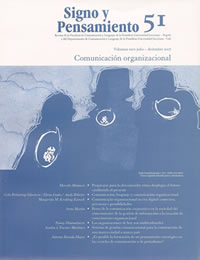Abstract
Today, a large number of organizations and companies are multicultural, not only because they operate in countries or environments where several cultures meet, but also because they are exposed to a wide variety of values and practices. This diversity forces us to think about how new organizations develop their own culture and practices. Hofstede sustains that, unlike national cultures, corporate cultures do not involve the question of sharing values but of having common practices. Thus, corporate practices must be analyzed in order to recognize diversity and to solve differences.Cortina, A. (1997), Ciudadanos del mundo. Hacia una teoría de la ciudadanía, Madrid, Alianza.
Grande, I. (2004), Marketing croscultural, Madrid, ESIC.
Gubern, R. (2005, julio-diciembre), “La nueva amalgama intermedial”, en Signo y Pensamiento, vol. XXIV, núm. 47, pp. 29-39.
Hall, E. (1973), The Silent Language, New York, Anchor Books.
Herrera Mora, C. (2005), “La valoración del capital cultural, comparativo entre Colombia y Venezuela”, en Observatorio de la Economía Latinoamericana [en línea], núm. 43, disponible en: http://www.eumed.net/cursecon/ecolat/ve/2005/chm-ccv.htm#3.
Hofstede, G. (1999), Culturas y organizaciones. El software mental, Madrid, Alianza. Rapaille, C. (2006), El código cultural, Bogotá, Norma.
Sison, A. J. G. (2005), “Filosofía de la economía III. Los fundamentos antropológicos de la actividad económica”, en Cuadernos Empresa y Humanismo, núm. 53, 31 pp.

This work is licensed under a Creative Commons Attribution 4.0 International License.
Copyright (c) 2021 Fanny de Hilmmelstern


